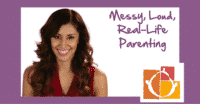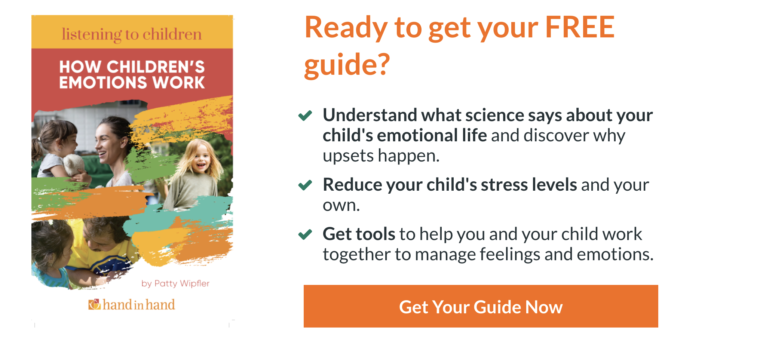My grandmother died when my daughter was two years old. My grandmother and I had been really close, so I was devastated.
For a while it was hard to do the simplest of tasks, like getting out of bed, or making a cup of tea. Just looking after my daughter’s basic needs was all that I could do.
I even started shouting at her, without meaning to.
Just when it was hardest to connect with her, she began telling me how much she needed me by kicking me, and constantly wanting to roughhouse and play.
It was hard to be the mom I wanted to be when I felt so bad.
How to find support and healing to move on
I turned to my Listening Partnership, one of the key Listening Tools of Hand in Hand Parenting, to deal with my grief. In a Listening Partnership, two parents get together to exchange time talking about how parenting is going with a listener who doesn’t offer advice or solutions, but simply gives the other the space to process their feelings.
I did as much listening time as possible.
I got to talk and cry about how much I missed my grandmother. I also got to moan about my daughter’s off-track behaviour, and how hard it was to find the energy to connect with her.
I cried about the loss of our close connection, and how powerless I felt to improve things when I felt so sad. Gradually things shifted and I found the energy to play and laugh with her again.
Now my relationship with my daughter is wonderful again. I can no longer see any damage from that difficult time. It’s as if that story is woven seamlessly into the history of our lives.
She is happy and loving life. I am too.
Why life events can cause broken connections
My story is not unique. For all of us, life happens. A family might have experienced a big change: perhaps a new sibling arrives, or they must move house, or they go through a divorce. Or perhaps a child has a challenging start in life because of a difficult birth or post-natal depression.
Major life events can cause our relationships with our children to fray. Their behavior then goes off-track.
It’s not our fault that life gets hard!
It's important to take care of yourself first
But there are things we can do to make our lives, and our children’s lives, better. Often, we need to do our own healing. We need to put our oxygen mask on first, before we reach to help our child. The tool of Listening Partnerships is a good one to start with!
I’ve found it helpful to think of myself as starting over when my connection with my child breaks down.
I start with the question, “Are hurt feelings from my past getting triggered by what’s happening now?
Our feelings are like veils on reality, so they can make us see the relationship with our child with hopelessness and despair, or other feelings we are familiar with from earlier in our lives.
With a Listening Partner, or even with a good friend who won’t judge us, we can let down our hair, talk, and cry about the difficult times in our lives. We can grieve for the lost connection. We can shed layers of feelings, see things differently, and cultivate a sense of hope that things can change.
After lots of listening time you’ll be ready to put connection with your child at the top of your to do list. You can let other things slide for a while.
Healing broken connections takes focus
Do little.
Set limits for sanity and safety but let the small stuff slide. Focus on connecting in a stress free way. Hang out in your pajamas, cook basic meals, let the cleaning slide. Spend time with friends you can have a laugh and feel comfortable with.
You can also introduce Special Time into your lives. Special Time is one-on-one time with your child where you let them do whatever they want while you shower them with love and attention. Set a timer for 10 or 15 minutes, and ask your child what they’d like to do.
Follow your child’s lead, and try not to set limits unless safety is an issue. Try to make Special Time a regular occurrence. It will help to deepen the bond between you and your child.
Spend a month or so focusing mainly on connection. Get to know each other again.
Keep your Listening Partnership going, so you can reflect on this reconnection process.
The limits and listening you do allow your child to recover from broken connection
After a month or so, you can focus again on setting limits whenever you notice your child is whiny, or her behaviour is off track.
With Hand in Hand Parenting, we set limits in a firm but loving way, then listen to whatever upsets bubble up. You don’t need to distract your crying child, or fix anything.
Crying is a healing process for children, too! When your child cries because she has the wrong colour cup, or because it’s time to get out of the bath, she focuses on that small issue, but will often do big work on a broken connection, or on other earlier difficulties in her life.
The Special Time phase of your reconnection project allows your child to soak up your warm loving attention.
When she senses that you are there and available, that you’ve done your own healing, she’ll bring up issues. The limits you set, and the listening you do will allow her to recover from the hurt that caused her off-track behaviour. You may notice she saves those feelings for the end of Special Time. Here's how you can handle those upsets.
We can repair, recover and heal
Hand in Hand Parenting isn’t about being the perfect parent all of the time. It’s about knowing that we can repair, recover, and heal, and we can help our children do the same.
With these tools, we have a thousand chances to start over.
 Do you want more suggestions on how to use Special Time?
Do you want more suggestions on how to use Special Time?
Check out our free video series. In the first video, you’ll get a step by step guide to using Special Time and some fun examples of what it can look like. Get your videos now.
Free Guide: Understand your child's emotions and upsets
Kids don't come with a manual, and sometimes their behavior is just plain baffling. This guide shows you the science behind your child's emotions and upsets, plus gentle tools and strategies you can use to manage them.
